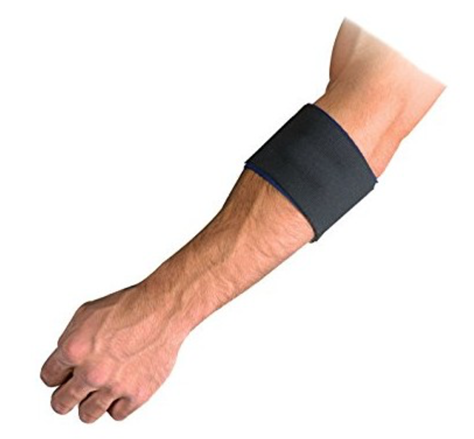Common Golfing Injuries
Golfers come in all shapes and sizes, different ages and level of skill. We all have varied swing techniques too. What is common to us all is that we all want to improve our game, achieve better scores and have a jolly good time on the golf course. It’s no surprise that we may develop some aches and pains along the way. Here is a list of common ailments that we may experience.
Knee Pain In Golfers

As we take our clubs into the backswing and rotate our body during the downswing, we do subject our leading leg (left knee in right handed golfers) to high levels of torque and stress. This is especially so during the moment of impact between the club head and ball. As the swing is completed, the leading leg bears almost all of the body weight and is twisted as we ensure a good follow through for our swing. Repetition of the golf swing may lead to injuries around the knee namely meniscal tears, ligament sprains or even ruptures of certain ligaments. Even the legendary Tiger Woods tore his left Anterior Cruciate Ligament (ACL) with all that torque force around his knee! Patients with underlying knee arthritis may develop pain and stiffness in their knees.
How to prevent knee injuries in golf
If you feel sore after hitting a hundred balls at the range, it may not be a bad idea to cut down the number of balls you hit or spend more time with your short irons instead of the driver.
If you are always in severe pain after every session at the range or on the course, it may be a good idea to consult a golf professional to assess your golf swing. Poor posture and swing biomechanics may be the cause of it and may be rectified by a certified golf professional.
It is important for general health and fitness to visit the gym for strength training and core strengthening. Strong muscles help to protect your joints against injury, regardless of the sport you play.

Always warm up before hitting the balls

Reduce the number of balls you hit at the range

Consult a golf professional about your swing biomechanics and posture
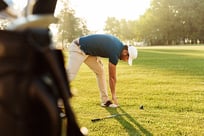
Do specific exercises to strengthen your core muscles
What to do if you are a golfer with knee pain
As an avid golfer who occasionally experiences knee pain myself, I would first rest my knee for several days and ice it down if there is any evidence of swelling. If the pain is moderate to severe and I find myself limping, I would take some anti-inflammatories like Arcoxia or Diclofenac to reduce the pain and inflammation. Some compression around the knee is often helpful

- Rest
- Ice
- Compression
- Anti-inflammatories (Arcoxia, Diclofenac, Naproxen)
Some patients have pain that is worse with weight bearing exercises. We would
An orthopaedic surgeon will conduct a thorough clinical examination of your knee to determine the exact location of your knee pain and exclude instability of the knee. An X-ray and MRI scan of your knee may also be done to exclude any serious knee injuries such as meniscal tears, ACL ruptures or cartilage wear.
What if I have a serious knee injury?
Most knee injuries may be treated conservatively with adequate rest, cold compression and anti-inflammatory medication. For certain persistent and severe conditions, intra-articular injections with lubrication (visco supplementation) or blood (platelet rich plasma PRP, autologous protein solution APS) may temporarily relief pain and accelerate your return to golf.
MENISCUS TEARS
Meniscus tears in the leading knee is a common golf-related knee injury. The meniscus is a shock absorber of the knee. Without it, the two bones in our knee (femur and tibia) will undergo accelerated wear and tear leading to early onset arthritis. Tears of the meniscus tend not to heal by themselves due to their poor blood supply. There is also a spectrum of simple and complex meniscal tears. Simple tears of the meniscus may be repaired using arthroscopic or key-hole techniques. Complex tears may be partially repaired or partially trimmed if they cannot be repaired. This is to prevent the tears from propagating and getting bigger.
Patients with moderate to severe knee arthritis which had been bothering them for a considerable period of time may consider a knee replacement to help with their long standing knee pain, stiffness and loss of function. It is important to understand that knee replacements are designed to allow patients to return to a relatively active lifestyle including moderate physical activity, prolonging their employment, going on holidays and taking care of their loved ones. Gone are the days where patients are kept in bed for weeks after a knee replacement. We want our patients up and about as soon as possible to prevent muscle weakening and atrophy.
Can I play golf after a knee replacement?
Some indications that you have recovered fully include:
- Your surgical wounds must have healed fully;
- The swelling in your knee should have resolved completely;
- The muscle strength in your thighs, calves and hamstrings must be restored and improved on;
- You must be able to walk comfortably and without difficulty on flat ground, slopes and stairs;
- Please seek approval from your orthopaedic surgeon before you return to the golf range or golf course. Your surgeon will know you and your knee best.
There are many factors to be considered when one plays golf after a knee replacement. These include:
- Which knee was operated on? Your leading leg (left leg in a right handed golfer) or trailing leg?
- Do you walk (carry your own bag or use a trolley) or do you take a buggy through 9 or 18 holes?
Are you able to abandon walking and convert to a buggy halfway through a game? - Is your local golf course relatively flat or hilly?
- What are your aims and goals when playing golf?
◇ Social golf with friends?
◇ To walk 18 holes and maintain general health and fitness?
◇ To maintain that long drive from the tee box?
◇ To maintain that single handicap that you’ve manage to keep for the last 10 years?
◇ To improve your golf game and handicap?
◇ To go on that long-awaited trip to St. Andrews and play on their famous links course?
Journal papers (no need to publish on website)
- − Can return safely to sport (Return to Golfing Activity After Joint Arthroplasty, Papaliodis, Am J Sports Med Jan 2017)
- − Golf handicap does not change significantly following lower extremity total joint arthroplasty (Lower extremity Total joint arthroplasty has minimal effect on golf handicap, M Brown, J Surg Orthop Adv 2020)
- − Stationary cycling is recommended rather than playing golf following TKR who wish to remain physically active. Three-dimensional knee joint kinematics during golf swing and stationary cycling after total knee arthroplasty. S Hamai. J Orthop Res. Dec 2008
- ● Average time to return to 18 holes course was 3.7 months
- ● Participants played at a higher level than before surgery, with handicap improvement of 0.85 and increasing their weekly playing time from 8.9 to 10.2 hours.
- ● Knee pain while playing golf decreased after surgery (6.13 to 1.27 on the visual analogue score) and UCLA score (7.02 to 7.85)
- − Ability of regular golfers to return to golf within six months after unilateral total knee replacement, with increasing level of golf and weekly playtime, and better golfing comfort. A Playtime and handicap analysis of 143 regular golfers after total knee arthroplasty at minimum 2-year follow-up. C Pioget. J Arthroplasty. May 2020.
Neck and Back Pain associated with Golf

Pain in the sides of necks, between our neck and shoulders, as well as in the lower back are frequent ailments that golfers face regularly. Often, these are muscle-related pain due to lack of stretching before and after the games or poor swing biomechanics.
The trapezius muscle is a large muscle that extends from the back of our skull, to the upper back between our shoulder blades (scapula) and towards the lower thoracic spine. It works hard to support the weight of our arms, control and rotate our scapula and spine, and contract to extend our neck (when we hold our head up or look upwards).
Imagine the stress on our trapezius muscles as we address the ball in a stable posture, proceed to rotate our spine in the backswing and release during the down swing through impact and follow-through! And as a bogey player, I do this at least 90 times in a game. It is no wonder we get neck, upper and lower back aches playing our favourite sport.

The latissimus dorsi muscle is the largest muscle upper body, covering most of the lower back and stretches to the sides and arms. It facilitates movement of the arms, shoulders and works synergistically with other muscles of the lower back when you lean over, arch your back backwards, and flex your back sideways. It doesn’t work in isolation works with other muscles in the lower and upper back. Tight latissimus dorsi muscles are known to contribute to chronic shoulder and back pain since this muscle connects the spine to the upper arms (humerus).
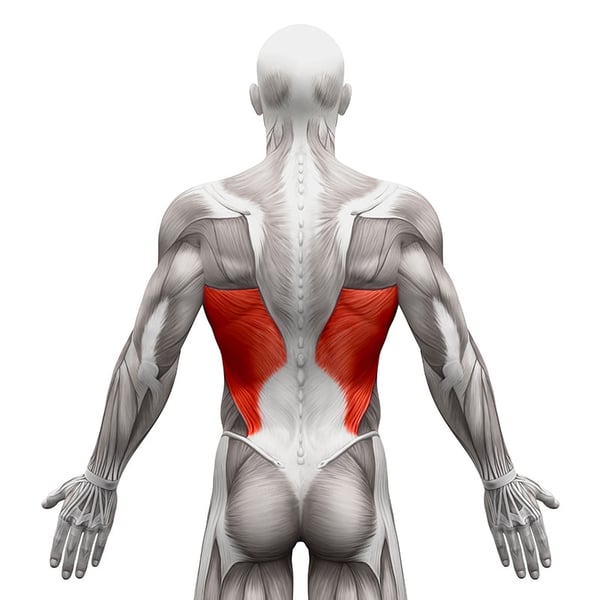 Prevention is better than cure.
Prevention is better than cure.
As always, a pre-game routine and stretch is crucial to prevent these injuries. A proper 5 to 10 minute stretch focusing on our necks, shoulders, upper and lower back is important.
It’s always good to arrive about 30 to 45 minutes before a game. It calms us down and improves our tempo going into our game.
If you’re late and your mates are already on the first tee box, it might not be a bad idea to let them tee off first while you stretch. You can always start on the second hole after a good stretch rather than pull a muscle and drag your first ball into the nearby stream! Yes, we have all been there and will likely do it again!
What would you consider a serious neck or back injury?
- Constant pain at rest and at night despite adequate rest and care. Pain that wakes you up at night. Sharp shooting pain to your arms.
- Tingling, numbness and/or weakness in your arms and fingers
- Clumsiness in your hands eg difficulty holding a pen or chopsticks, unable to button your shirt
- Clumsiness or instability when walking
- Trouble going to the toilet
- Sharp shooting pain to your legs. This may or may not be associated with tingling and numbness in the calves or toes.
Shoulder Pain associated with Golf
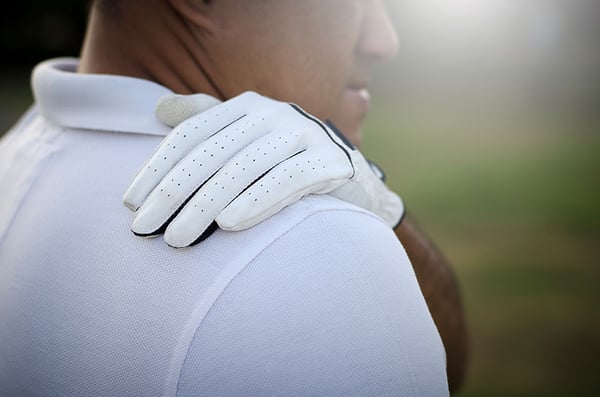
There are many reasons why you might be experiencing shoulder pain when playing or after playing golf. These injuries come mostly from overuse and often affect the lead shoulder (left shoulder in right handed golfers).
Here are several tips you may adopt to protect your shoulder from injury:
- Stop playing if your shoulder is hurting while you are golfing. You can always return to the game another day once your shoulder is better.
- Ensure you have adequate rest after a strenuous golf session. You may use ice and anti-inflammatory medicine to reduce the pain and swelling in your shoulder if present.
- Be sure to use your golf swing and biomechanics with your golf pro.
- Avoid carrying your golf club over your injured shoulder. Either use a trolley or a buggy to do the heavy work for you!
- Strengthen the muscles around your shoulder and back at the gym. There are many muscles in our body which have to work together and harmoniously. Strong muscles help prevent injuries and compensate for injuries around your joints.
- It is important to do your regular stretching before and after any golf game or practice. Tightness in one muscle may lead to pain in another.
Common MRI findings in golfers with shoulder pain

ROTATOR CUFF TENDINITIS
ROTATOR CUFF TEARS

LONG HEAD OF BICEP TENDON INJURIES
This condition may be treated conservatively with adequate rest, ice packs and anti-inflammatory medication. If the tendon completely ruptures, you might notice a bulge over your bicep muscles itself. Please seek the help of an orthopaedic surgeon if this happens.

Elbow Pain in Golfers
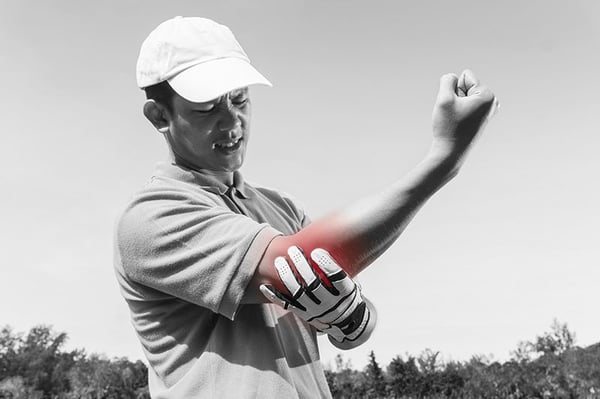
Golfers Elbow (medial epicondylitis) is a condition where tendons of your forearm muscle that attach to the bony prominence on the inside of your elbow are inflamed, causing pain and a weak grip. This is an overuse injury of the wrist flexors and pronator muscles in the forearm and may affect anyone, not just golfers!
Tennis elbow (lateral epicondylitis) is a similar condition affecting tendons of your forearm muscles that attach to the outside of your elbow. This condition is also not just limited to tennis players but anyone who stresses the wrist extensors and supinator muscles of the forearm.
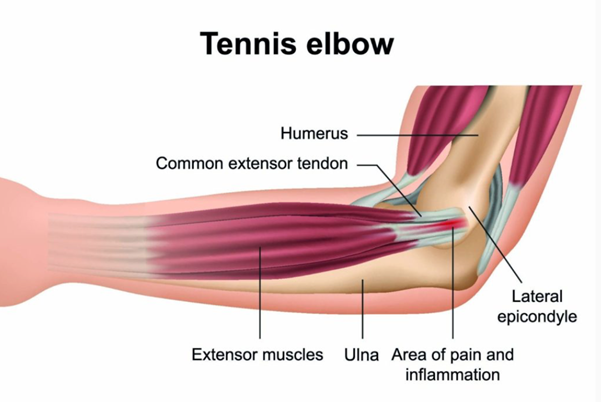

Repetitive throwing, twisting, or lifting the forearm may cause this inflammatory condition around the elbow. Any golfer with pain in the inner aspect of your elbow shoulder consider the following factors:
- Grip strength. If you clutch or grip your clubs too hard all the time, you will undoubtedly stress the muscles of your forearm and may develop pain on the inside or outside of your elbow, or both! Relax your grip and reduce the tempo of your swing.
- Grip size. Consider the size of the grips at the top of your irons, woods and driver. If the grip is too small, you will end up unnecessarily stressing the muscles in your forearm. Please go to the nearest pro shop and try a larger grip for your equipment.
- Grip quality. Some of us have never changed the grip for our clubs. Each grip has a specific firmness and texture that would suit your individual game. Grips that are worn out with little texture will make players use excessive hand pressure to create a confident grip on their club. This lack of hand traction and gripping confidence will overstrain your forearm muscles and lead to pain around the elbow.
- Wear a brace. Consider wearing a forearm muscle splint for either golfer’s or tennis elbow. This brace is worn about two finger-breadths below the elbow crease and works to take the strain off the affected tendon. This brace is to be worn even when not playing golf and for a period of about four to six weeks.
